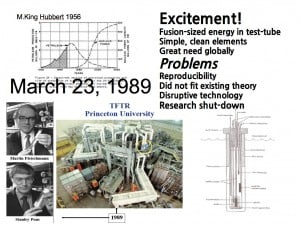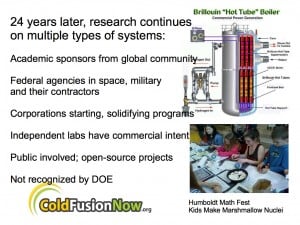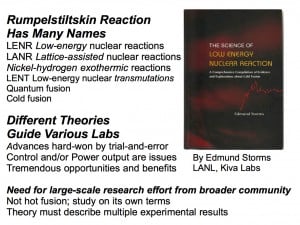Photo Ruby Carat at LASER courtesy Michael Shields
Cold Fusion Now spoke at the LASER event hosted by Art/Sci on Thursday, February 21 on the UCLA campus.
 Akin to speed dating for your corpus callosum, the salon where artists meet scientists (and vice versa) attracts a wide range of creative individuals who present their ideas in 5-minute intervals.
Akin to speed dating for your corpus callosum, the salon where artists meet scientists (and vice versa) attracts a wide range of creative individuals who present their ideas in 5-minute intervals.
The title of my five minutes was New Energy Emerging.
Too bad I didn’t even get through half of it, and not even to the Newly Emerging part. Was I sleepin? Next 5-minute gig – step it up!
The vibe was positive, and Cold Fusion Now has made a connection. Putting more minds to the questions of cold fusion can only be a good thing. We can figure this out collectively, so let’s get some more brain power on it!
New Energy Emerging
 M. King Hubbert’s 1956 prediction that nuclear power would carry human civilization far in a technological future became a real possibility in 1989 when Drs. Martin Fleischmann and Stanley Pons announced their discovery of fusion-sized excess heat generated in a small table-top electrolytic cell.
M. King Hubbert’s 1956 prediction that nuclear power would carry human civilization far in a technological future became a real possibility in 1989 when Drs. Martin Fleischmann and Stanley Pons announced their discovery of fusion-sized excess heat generated in a small table-top electrolytic cell.
A charge applied to a palladium cathode and a platinum anode immersed in a heavy water solution creates excess heat with magnitude so great, it must be of nuclear origin, though little to no radiation is measured.
Scientists around the world dropped everything and became electro-chemists overnight attempting to reproduce their results.
Unfortunately, only about 15% of those attempts were successful, and, it doesn’t fit the conventional theory of nuclear reactions of one hundred years ago based on fusion in hot plasmas.
The pair was denounced and cold fusion was abandoned by mainstream science.

2 24 years later, the 15% who did reproduce the effect have gradually understood many of the things that prevented earlier success.
Multiple materials are known to initiate excess heat and transmutation products. Gas-loaded cells and nano-particles have become a focus. One local researcher at University of LaVerne uses nano-palladium loaded zeolites exposed to D gas to initiate excess heat.
Public, open-source projects are linking nuclear scientists with skilled citizens world-wide to reproduce results, and while the governments of China, Japan, Italy, Sweden and others are supportive, the US Department of Energy does not acknowledge this science.

3 Why is this so important? With a water fuel, there’re no CO2 emissions.
This is nuclear power, but no radioactive materials are used, and the transmutation effect offers a path to ridding the planet of nuclear waste.
Nuclear products are so little and few, they are difficult to detect. Some cells produce only helium.
One estimation for ERoEI was 3000 to 1; a unit the size of a microwave can power your home, no electrical grid needed.
We can remove hydro-electric dams, restore waterways and wilderness, and it becomes economically-viable to recycle all waste.
So what’s the problem?
And that’s where the room was left hanging!
Here’s what I didn’t get to:

4 There is no definitive theory that describes these effects; no recipe defining how to make the reaction happen; advances have been hard-won by trial-and-error.
A different theory guides each commercial prototype. The many names trace the various models.
But lack of theory won’t stop commercial development which suffers from two issues:either control of the reaction, or stability of the high-power output.
Cold fusion is not hot fusion, and we need a coordinated research strategy to solve this.
5 Put the power of your minds to collectively form a solution to one of the greatest scientific questions before us.
Experts in the field can provide a full survey of the experimental evidence over two-and-half-decades, along with an overview of how these measurements have been made. Reach out to local scientists in this field.
Marshall McLuhan taught the greatest changes to society are due to new technologies.
Look at this not just for the excitement of discovery, but to secure the chance for a green, technological human future on Earth and beyond.
Thank you.






